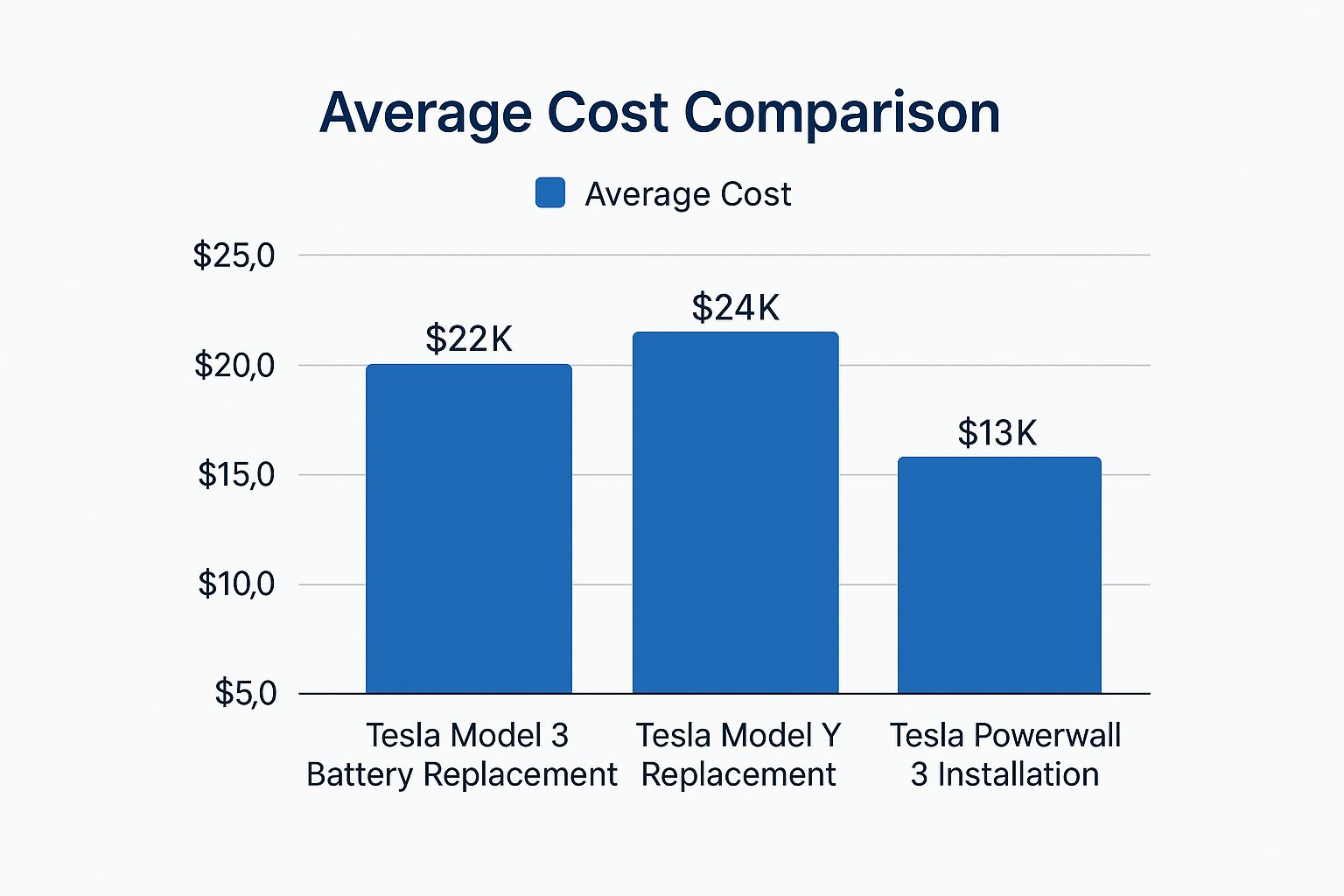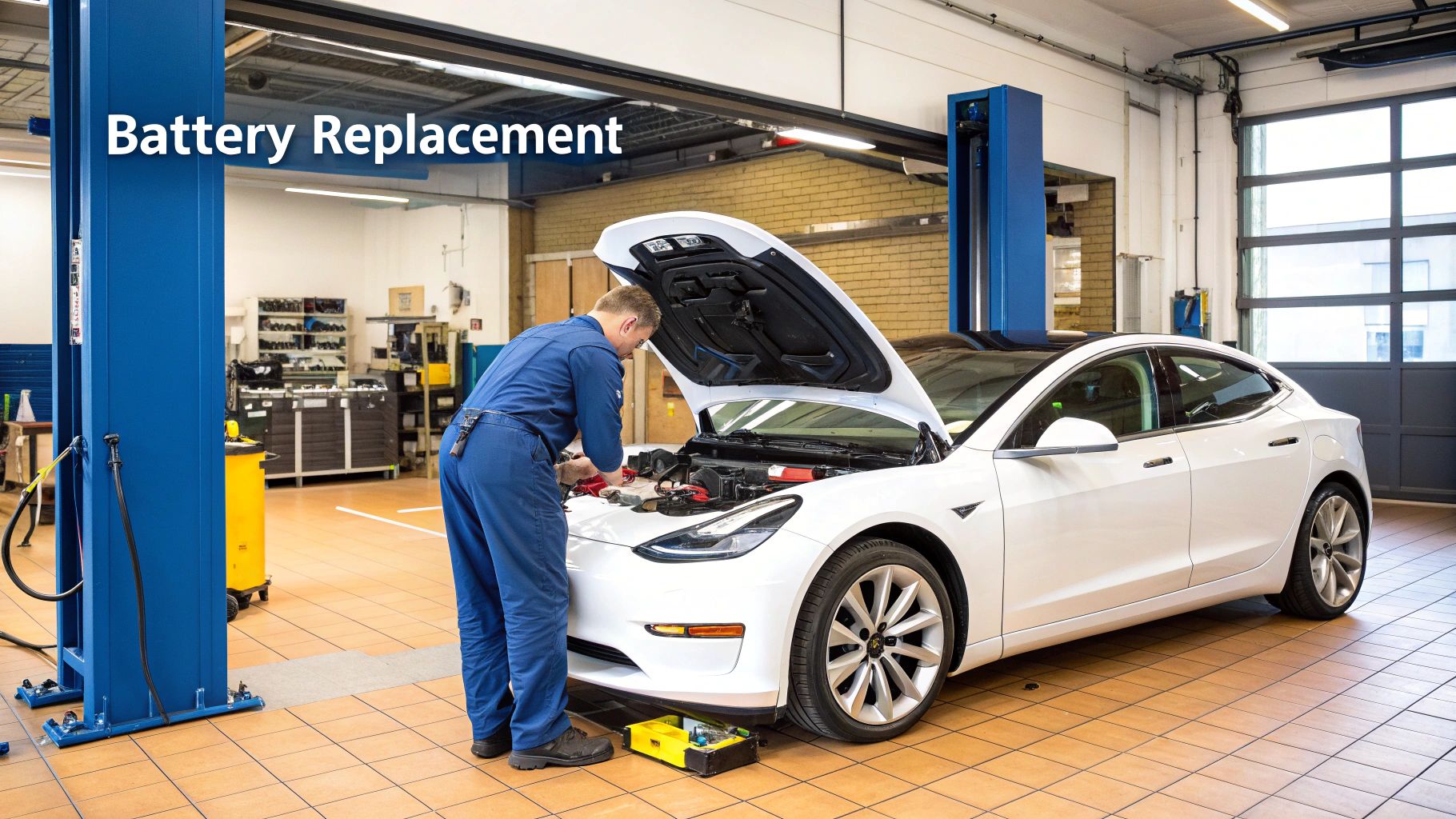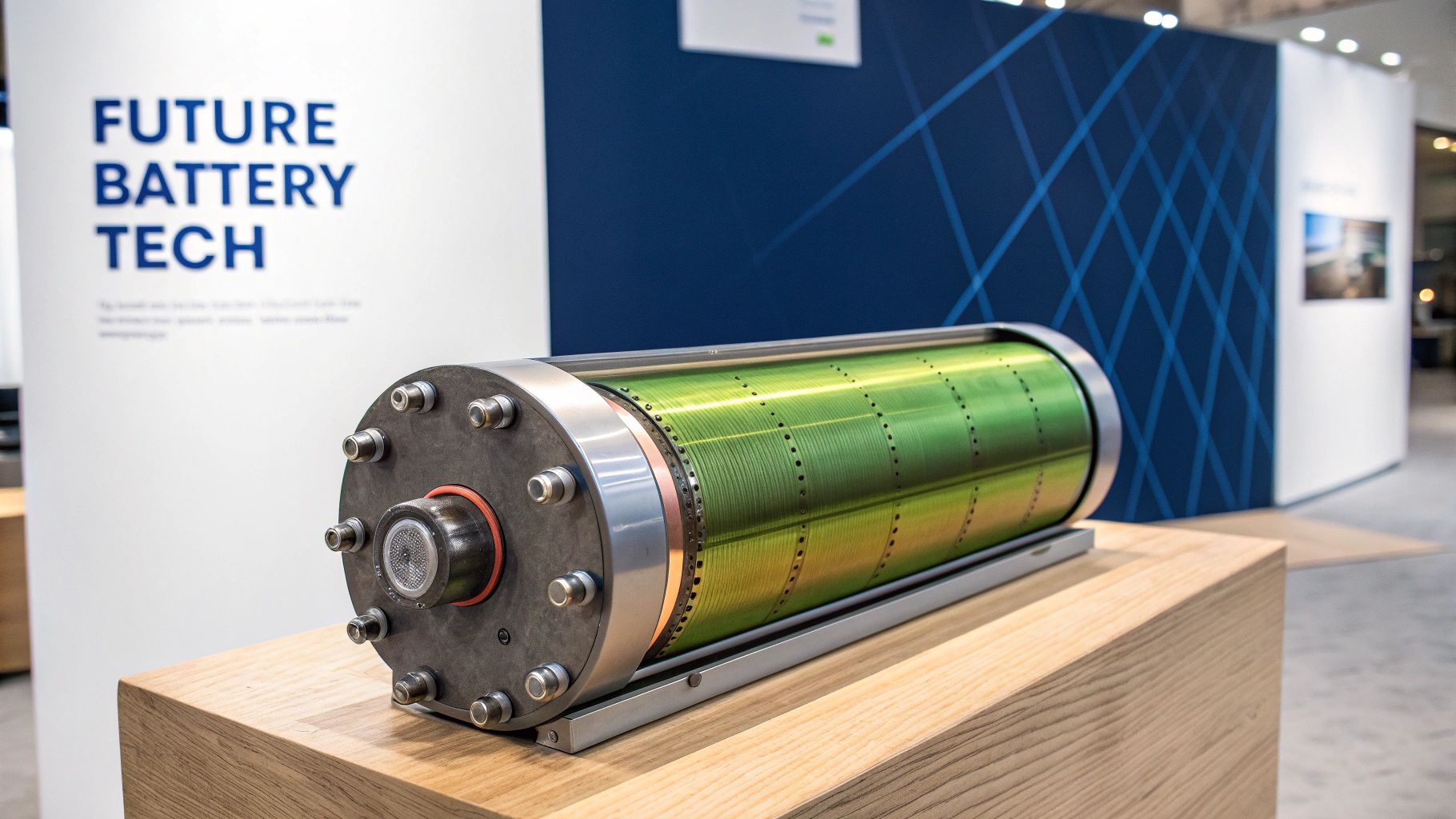How Much Is a Tesla Battery? Complete Cost Breakdown
When people ask, "how much is a Tesla battery?", the real answer is: it depends which one you mean. A new battery for a Tesla vehicle and a Tesla Powerwall for your home are two completely different beasts, with wildly different price tags.
The price for a new Tesla battery can swing anywhere from $13,000 to over $25,000 AUD. That's a huge range, and it all comes down to whether you're dealing with an out-of-warranty car repair or making a planned investment in your home's energy setup.
Decoding Tesla Battery Prices
Let's clear this up first. A replacement battery for a Model 3 or Model Y is a major, often unplanned expense that comes after your warranty has run its course. It’s a repair job, pure and simple.
A Tesla Powerwall, on the other hand, is a conscious choice. It's an appliance you buy to store solar energy, giving you backup power and more control over your electricity bills. Think of it as an investment in energy independence, not a grudge purchase for your car.
Getting this distinction right is the first step to figuring out the actual cost.
To put it in perspective, here’s a quick look at how the numbers stack up for Tesla's most common batteries in Australia.

As you can see, swapping out a car battery is a much heavier financial lift than adding a Powerwall to your home. We'll break down the costs for both scenarios to help you get a handle on what to expect.
Estimated Tesla Battery Costs at a Glance
The financial outlay for a Tesla battery looks very different depending on whether it’s for your car or your home. This table summarises the ballpark figures you'd be looking at in Australia, including the battery itself and the cost of getting it installed.
| Tesla Product | Battery Type | Approximate Capacity (kWh) | Estimated Cost (AUD, Installed) |
|---|---|---|---|
| Model 3 | Vehicle Replacement Pack | 60 – 75 kWh | $20,000 – $25,000 |
| Model Y | Vehicle Replacement Pack | 60 – 75 kWh | $22,000 – $27,000 |
| Powerwall 3 | Home Energy Storage | 13.5 kWh | $13,000 – $16,000 |
The numbers tell a clear story. While neither is pocket change, fitting a Powerwall in your home is generally about half the cost of a post-warranty battery replacement for a Model 3 or Y.
The Real Cost of a Tesla Battery Replacement

Sooner or later, every owner of an out-of-warranty Tesla asks the big question: "how much will a new battery set me back?" For Australia's most popular models, the Model 3 and Model Y, a complete battery pack replacement is a serious investment, typically landing somewhere between $20,000 and $27,000 AUD once you factor in labour.
That figure is the worst-case scenario, the kind of bill you face when the entire high-voltage battery gives up the ghost. But it’s not always an all-or-nothing affair. Often, the real culprit is just a single faulty module inside the pack.
Full Pack Replacement vs. Module Repair
Think of your Tesla's battery pack like a string of old-school Christmas lights. If one bulb goes out, you don't throw away the whole string. It's a similar story here. A Tesla battery is built from several individual modules, and a skilled technician can sometimes pinpoint and replace just the one that's failed. That's a far more wallet-friendly fix.
- Full Pack Replacement: This is the complete swap. The old battery unit comes out, and a new or remanufactured one from Tesla goes in. It's the most expensive route but gives you a fully refreshed system.
- Module Repair: This is surgical. A technician targets only the damaged part of the battery. This approach can save you thousands but demands specialised diagnostic tools and serious expertise.
For an out-of-warranty battery problem, a module-level repair is usually the most sensible first step. It solves the specific issue without the massive expense of replacing components that are still in perfect working order.
The right choice really depends on what’s gone wrong. A widespread internal failure might leave you with no option but a full replacement. But if it’s just an isolated fault, a module repair is the way to go. To get a better sense of where this technology is heading, have a look at our insights into automotive mobility and energy solutions.
What Influences the Final Bill?
A few key things dictate the final price you'll pay. The battery’s chemistry and its capacity are the biggest drivers of the parts cost.
For example, the 2025 Tesla Model Y lineup in Australia uses different battery technologies. The standard Rear-Wheel Drive (RWD) model gets a 62.5 kWh Lithium Iron Phosphate (LFP) battery. Step up to the Long Range or Performance variants, and you get larger 75 kWh Nickel Cobalt Aluminium (NCA) packs. This recent car news update breaks down the specifics.
Beyond the hardware itself, the labour costs at the service centre play a big part. Swapping out a battery is a complex, heavy-lifting job that takes hours, and that time on the hoist adds up quickly.
Finally, don't forget your warranty. Tesla’s Battery and Drive Unit Limited Warranty has your back for 8 years or a set number of kilometres (like 160,000 km for a Model 3 RWD). Crucially, this warranty also covers significant degradation—if your battery’s capacity drops below 70% within that period, you're covered. It’s a solid bit of long-term peace of mind.
Investing In Home Energy With The Tesla Powerwall

Let’s shift the conversation from cars to the home. The Tesla Powerwall answers the "how much is a Tesla battery?" question in a completely different way. This isn't a repair bill; it's a front-footed investment in your home's energy future.
Think of it as your own private energy reservoir. It lets you store the free solar power your panels generate during the day, rather than dribbling it back to the grid for pennies. It also means you can top up on cheap off-peak electricity overnight.
You then use that stored energy when grid power is most expensive, taking a serious slice out of your bills and giving you a buffer against an increasingly shaky grid.
Breaking Down The Powerwall 3 Cost
For Australian homes, the Powerwall 3 is the current standard. You can expect the total installed price to land at around AUD 15,000. That figure typically wraps up all the hardware and the crucial professional installation needed to get it running safely and properly.
So, what are you actually paying for? The total cost breaks down into a few key parts:
- The Powerwall 3 Unit: This is the battery itself and the biggest piece of the puzzle, usually costing around AUD 11,900.
- Tesla Backup Gateway: This smart box is non-negotiable. It manages your grid connection and is what allows your home to stay powered during a blackout.
- Installation & Electricals: This covers the time and expertise of certified installers, plus any extra wiring and components required for a fully compliant setup.
The Powerwall 3 packs 13.5 kWh of usable energy storage. It's a solid unit designed specifically for modern household needs.
What Do The Specs Mean For Your Home?
So, what does 13.5 kWh of capacity actually get you? In practical terms, it’s enough juice to run your essential appliances—think fridge, lights, modem, and a few other bits—through the evening and into the night.
It’s a significant buffer that delivers real savings day-to-day and invaluable peace of mind when the street goes dark. The Powerwall 3 is a robust solution for most residential setups, built to handle the demands of a typical family home.
By pairing a Powerwall with solar panels, you take back control. It's one of the most effective ways to shield your family from rising electricity prices over the long haul. If you're weighing up this kind of upgrade, understanding how to put together effective residential systems is the perfect starting point.
Key Takeaway: A Tesla Powerwall does more than just store power. It turns your home from a passive energy user into a smart energy hub. You store cheap or free energy, protect yourself from outages, and build long-term savings that eventually pay back the initial investment.
The Key Factors That Influence Your Final Price
The sticker price for a new Tesla battery is only ever part of the story. The final amount you actually pay, whether it’s for a car or a home Powerwall, hinges on a few critical variables. Getting your head around these factors helps you budget properly and know exactly what to ask when you get a quote.
When it comes to Tesla vehicles, the model you drive is easily the biggest cost driver. It makes sense that a battery for a flagship Model S or Model X with its massive capacity will cost more than one for a standard-range Model 3. The specific capacity, measured in kilowatt-hours (kWh), has a direct impact on the price—more capacity simply means more materials and a higher bill.
Another crucial choice is whether you opt for a brand-new battery pack or a remanufactured one. For replacements, Tesla often uses remanufactured packs, which can be a much more cost-effective option than a fresh unit straight from the factory. Don’t let the name fool you; these are fully tested and certified packs that deliver comparable performance at a lower price.
What Determines Your Powerwall Cost
For the Tesla Powerwall, the variables are different but just as important. The complexity of the installation is a major one. A straightforward job where the unit is mounted right next to your switchboard will always be cheaper than a complex setup that needs a lot of new wiring or even trenching.
The number of Powerwall units you install also scales the price. While one unit is plenty for many homes, larger properties or households with higher energy needs might install two or three. Each extra unit adds to both the hardware and the labour costs.
Don't forget to look into local incentives. Many Australian states and territories offer significant rebates or interest-free loans for home battery installations. These programs can slash thousands off the upfront cost, making the whole investment far more approachable.
Finally, where you live plays a role, especially for vehicle battery replacements. Labour rates can differ between major cities and regional areas, and that will show up on the final installation invoice from a Tesla Service Centre. Always ask for a detailed quote that breaks down parts and labour so you can see the complete picture.
Here’s a quick summary of the main cost influencers:
-
For Vehicles:
- Tesla Model: A Model S/X pack is pricier than a Model 3/Y pack.
- Battery Capacity (kWh): Higher capacity equals a higher cost.
- New vs. Remanufactured: Remanufactured packs can offer significant savings.
- Service Centre Location: Labour rates can vary by region.
-
For Powerwall:
- Installation Complexity: Simple installs cost less than complicated ones.
- Number of Units: The price increases with each additional Powerwall.
- Government Rebates: State-level incentives can dramatically lower your final cost.
How Evolving Battery Tech Affects Your Wallet

The world of battery technology is always in motion, and these rapid changes have a direct impact on your wallet when it comes to Tesla battery costs.
Think of it like computer chips. What was once groundbreaking and wildly expensive quickly becomes the affordable standard. The exact same thing is happening with the batteries that power our cars and homes.
For Australian consumers, one of the biggest shifts has been Tesla's move to Lithium Iron Phosphate (LFP) batteries for its standard-range vehicles. This isn’t just a tweak to the chemical formula; it’s a major step in making electric vehicles tougher and more accessible for everyone.
The Rise of LFP Batteries
Traditional Nickel Cobalt Aluminium (NCA) batteries rely on cobalt, a rare and expensive material with a shaky supply chain. LFP chemistry cuts cobalt out of the picture entirely.
By removing it, manufacturers can build batteries more cheaply and reliably. This simple change helps keep the initial price of the car down and lowers the potential sting of a replacement years down the track.
But the good news doesn't stop at the price tag. LFP batteries also have a longer lifespan. They can handle more charge and discharge cycles before they start to degrade, meaning your battery stays healthier for longer. That pushes the need for a costly replacement much further into the future.
This durability, combined with a lower manufacturing cost, simply delivers better long-term value. As battery chemistry continues to evolve, it's also worth keeping an eye on emerging tech like SodiumSAFE batteries, which promise even greater sustainability and safety.
Key Insight: The switch to cobalt-free LFP batteries is a game-changer for reducing the long-term cost of EV ownership. It makes both the car and any future battery replacement more affordable for everyday Australians.
Packing More Power into Less Space
Alongside new chemistries, engineers are constantly improving energy density. In simple terms, this is about how much energy you can cram into a battery of a certain size and weight.
Higher energy density is a win-win. It means a battery can hold more power without getting bigger or heavier, which directly translates to more driving range for your car.
You can see this continuous improvement in recent updates. For instance, Australian owners of the newer Model 3 RWD now get a 62.5 kWh LFP battery from CATL, a nice upgrade from the old 60 kWh packs. This small change bumped the car's official WLTP range from 513 km to 520 km, and the battery pack even became 1 kg lighter in the process.
These small, steady gains really add up. As manufacturing gets more efficient and energy density improves, the cost per kilowatt-hour (kWh) keeps falling. This trend is the driving force that will eventually make the answer to "how much is a Tesla battery?" a much smaller, friendlier number in the years to come.
Your Top Tesla Battery Questions, Answered
Once you start digging into the numbers, a few practical questions always come up. Let's tackle the most common ones we hear from Australians weighing up their options for a Tesla vehicle or a Powerwall at home.
How Long Does a Tesla Vehicle Battery Actually Last?
Think of a Tesla's battery less like the one in your phone and more like the engine block in a traditional car. It’s engineered to last the entire life of the vehicle.
The official benchmark is around 1,500 charge cycles. For the average Australian driver, that translates into a huge amount of road time—somewhere between 300,000 and 500,000 kilometres.
Battery health does fade over time, but it's a very slow and gradual process, not a sudden drop-off. More importantly, Tesla’s warranty has your back. If the battery capacity falls below 70% within the warranty period (typically 8 years or 160,000-192,000 km), Tesla will handle the replacement.
Can I Upgrade My Tesla’s Battery to a Bigger One?
It’s a common thought—can you swap in a bigger battery for more range? The short answer is no, at least not through Tesla.
A Tesla is a tightly integrated machine. The car's software, its cooling system, and all the crucial hardware are fine-tuned for the specific battery it rolled out of the factory with.
While a niche third-party workshop might technically perform a swap, it's not a path Tesla supports or recommends. Going down that road would almost certainly void your vehicle warranty and could introduce all sorts of performance and safety headaches. If a battery pack needs replacing, it’s swapped for one of the exact same size and type.
Are There Government Rebates for a Tesla Powerwall?
Yes, and this is where the upfront cost of a home battery can get a lot more interesting. Many Australian states and territories offer incentives to help homeowners install battery storage.
These programs are designed to make the investment far more manageable and can come in a couple of different flavours:
- Direct Rebates: Some states, like Victoria with its popular solar battery rebate, will give you a fixed amount of cash back once your system is installed.
- Interest-Free Loans: Other schemes let you finance the system with a zero-interest loan, so you can spread the cost over time without paying extra for it.
The key thing to remember is that these programs and their rules change. Before you sign anything, always check the official government energy website for your state or territory. A few minutes of research can literally save you thousands of dollars and make the case for a Powerwall a whole lot stronger.
Ready to make your solar and battery system work smarter for you? HighFlow Connect helps you earn more from your energy and provides blackout protection for your home. Discover how our VPP can reduce your bills and strengthen the grid.


